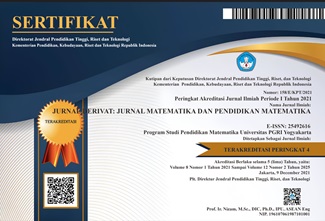Pengaruh Model Pembelajaran Auditory Intellectually Repetition Terhadap Kemampuan Multi Representasi Matematis Siswa Smp
DOI:
https://doi.org/10.31316/j.derivat.v6i2.501Abstract
Abstract
This study aims to determine the effect of the AIR learning model on students' multi-mathematical representation abilities, student activities and learning motivation. The population of this research is all students of class VIII. Samples were taken by simple random sampling technique. The selected sample consisted of two classes, namely VIIIB as the experimental class and VIIIC as the control class. This research is an experimental research design with Pretest-Postest Control Gruop. The results of the study can be concluded that: (1) There is a difference in the ability of multi mathematical representation of students in the class using the AIR learning model and the class using the direct learning model. (2) The effect of the AIR model is relatively high on the ability of students' multiple mathematical representations; 3) student learning activities as a whole are classified as very active; 4) student motivation is categorized high.
Â
Keywords : Auditory Intellectually Repetition, multi representations, student activities, studentÂ
motivationDownloads
Published
Issue
Section
Citation Check
License
Authors who publish with this journal agree to the following terms:
-
Authors retain copyright and grant the journal right of first publication with the work simultaneously licensed under a Creative Commons Attribution-ShareAlike 4.0 International License that allows others to share the work with an acknowledgment of the work's authorship and initial publication in this journal.
- Authors are able to enter into separate, additional contractual arrangements for the non-exclusive distribution of the journal's published version of the work (e.g., post it to an institutional repository or publish it in a book), with an acknowledgment of its initial publication in this journal.
- Authors are permitted and encouraged to post their work online (e.g., in institutional repositories or on their website) prior to and during the submission process, as it can lead to productive exchanges, as well as earlier and greater citation of published work (See The Effect of Open Access).







